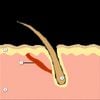Search
forLearn
2 / 2 resultslearn Scalp Micropigmentation
scalp tattoos to mimic the appearance of light stubble
Research
5 / 1000+ results
research Dermal Papilla Cells Serially Cultured with Wnt-10b Sustain Their Hair Follicle Induction Activity After Transplantation into Nude Mice
Cells treated with Wnt-10b can grow hair after being transplanted into mice.

research Lgr5 Marks Cycling, Yet Long-Lived, Hair Follicle Stem Cells
Lgr5 is a marker for active, long-lasting stem cells in mouse hair follicles.

research Defining the Transcriptional Signature of Esophageal-to-Skin Lineage Conversion
Adult esophageal cells can start to become like skin cells, with a key pathway influencing this change.

research Stress-Induced Chemokine Production by Hair Follicles Recruits Dendritic Cells to Sites of Minor Trauma
Hair follicles help attract immune cells to minor skin injuries.

research Single-Cell Analysis Reveals Fibroblast Heterogeneity and Myeloid-Derived Adipocyte Progenitors in Murine Skin Wounds
The research found that different types of fibroblasts are involved in wound healing and that some blood cells can turn into fat cells during this process.
Community Join
5 / 118 resultscommunity Scalp tension and thickness of the galea aponeurotica, inflammation and potential treatment pathways
Scalp tension potentially affecting hair loss, and potential treatments for male pattern baldness such as Minoxidil, Finasteride and RU58841. Evidence from a study was discussed which suggests that the cause of MPB lies within the follicle itself and is not dependent on its surrounding environment.
community How is verteporfin doing in trials?
The conversation is about the progress of verteporfin in hair loss trials, with users expressing curiosity about its effectiveness and updates. Specific treatments mentioned include FUE (Follicular Unit Extraction) combined with verteporfin, with one reported case of donor area regrowth after a year, and three patients being monitored post-treatment by Dr. Bloxham with monthly updates on YouTube.
community Physio-metabolic method of treating androgenic alopecia. Cold receptors. The relationship between DHT, cold receptors, minoxidil and antiandrogens.
A method for treating androgenic alopecia using minoxidil, antiandrogens, exercise, and cold exposure to promote hair growth. Environmental factors and lifestyle changes, like diet and exercise, can improve treatment effectiveness.

community Physio-metabolic method of treating androgenic alopecia. Cold receptors. The relationship between DHT, cold receptors, minoxidil and antiandrogens
Treating androgenic alopecia with minoxidil, finasteride, and antiandrogens, alongside exercise, cryotherapy, and natural substances to stimulate cold receptors for better hair growth. The method focuses on enhancing treatment effectiveness by considering environmental and behavioral factors and the role of cold receptors and muscle stress.
community Peptides that Stop Hair Loss? | In-depth Literature Review Video
Peptides like TB500, KPV, GHK-CU, and BPC-157 are overhyped for hair growth with limited proven effectiveness in humans. Combining peptides with delivery methods like iontophoresis and sonophoresis shows promise, but many claims remain unproven.